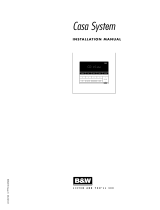
7 English
Protection Circuitry
The RB-1080 features a thermal protection cir-
cuit that protects the amplifier against potential
damage in the event of extreme or faulty
operating conditions. Unlike many designs,
the RB-1080’s protection circuit is indepen-
dent of the audio signal and has no impact
on sonic performance. Instead, the protection
circuit monitors the temperature of the output
devices and shuts down the amplifier if tem-
peratures exceed safe limits.
Most likely, you will never see this protection
circuitry in action. However, should a faulty
condition arise, the amplifier will stop play-
ing and the LED indicator on the front panel
will light up.
If this happens, turn the amplifier off, let it cool
down for several minutes, and attempt to iden-
tify and correct the problem that caused the
protection circuitry to engage. When you turn
the amplifier back on, the protection circuit
will automatically reset and the indicator LED
should go out.
In most cases, the protection circuitry activates
because of a fault condition such as shorted
speaker wires, or inadequate ventilation lead-
ing to an overheating condition. In very rare
cases, highly reactive or extremely low im-
pedance speaker loads could cause the pro-
tection circuit to engage.
If the protection circuitry triggers repeatedly
and you are unable to isolate and correct the
faulty condition, contact your authorized Rotel
dealer for assistance in troubleshooting.
Input Signal Connections
The RB-1080 gives you a choice of two dif-
ferent kinds of input connections – conven-
tional unbalanced RCA type connections (such
as found on nearly all audio equipment) or
balanced XLR-type connections for use with
some high-end preamps or digital processors
featuring this lower noise connection.
NOTE: To prevent loud potentially damag-
ing noises, make sure the amplifier is
turned off when you make any changes to
the input signal configuration.
Input Selector Switch
Set the switch to select the inputs that are be-
ing used. Set it to Unbalanced if the RCA inputs
are used. Set it to Balanced if the XLR inputs
are used.
RCA Inputs (unbalanced)
See Figure 2
When a component with RCA connectors –
such as a preamplifier or surround sound pro-
cessor – supplies signals to the RB-1080, the
RCA-type phono plug inputs should be used.
Select high quality audio interconnect cables.
Connect each of the outputs from the pream-
plifier or signal processor to the correspond-
ing Unbalanced Input of the RB-1080.
XLR Inputs (balanced)
See Figure 3
If you are using one of the high-end pream-
plifiers or processors with low-noise balanced
signal outputs to drive your RB-1080, you may
choose to use these low-noise XLR-type con-
nections. See your authorized Rotel dealer for
the appropriate cables.
Connect XLR audio interconnect cables from
each of the outputs from the preamplifier or
signal processor to the corresponding Bal-
anced Input of the RB-1080.
Speaker Connection
Speaker Selection
We recommend using loudspeakers with a
nominal impedance of 4 ohms or higher with
the RB-1080. You should exercise some cau-
tion in driving multiple pairs of speakers in
parallel configuration, because the effective
impedance the amplifier sees is cut in half.
For example, when driving two pair of 8 ohm
speakers, the amplifier sees a 4 ohm load.
When driving multiple speakers in parallel,
it is recommended that you select speakers
with a nominal impedance of 8 ohms or higher.
Speaker impedance ratings are less than
precise. In practice, very few loudspeakers will
present any problems for the RB-1080. See
your authorized Rotel dealer if you have any
questions.
Speaker Wire Selection
Use insulated two-conductor stranded wire to
connect the RB-1080 to the speakers. The size
and quality of the wire can have an audible
effect on the performance of the system. Stan-
dard speaker wire will work, but can result
in lower output or diminished bass response,
particularly over longer distances. In general,
heavier wire will improve the sound. For best
performance, you may want to consider spe-
cial high-quality speaker cables. Your autho-
rized Rotel dealer can help in the selection
of appropriate cables for your system.
Polarity and Phasing
The polarity — the positive/negative orien-
tation of the connections — for every speaker
and amplifier connection must be consistent
so all the speakers will be in phase. If the po-
larity of one connection is mistakenly reversed,
bass output will be very weak and stereo im-
aging degraded. All wire is marked so you
can identify the two conductors. There may
be ribs or a stripe on the insulation of one
conductor. The wire may have clear insula-
tion with different color conductors (copper
and silver). There may be polarity indications
printed on the insulation. Identify the positive
and negative conductors and be consistent with
every speaker and amplifier connection.








